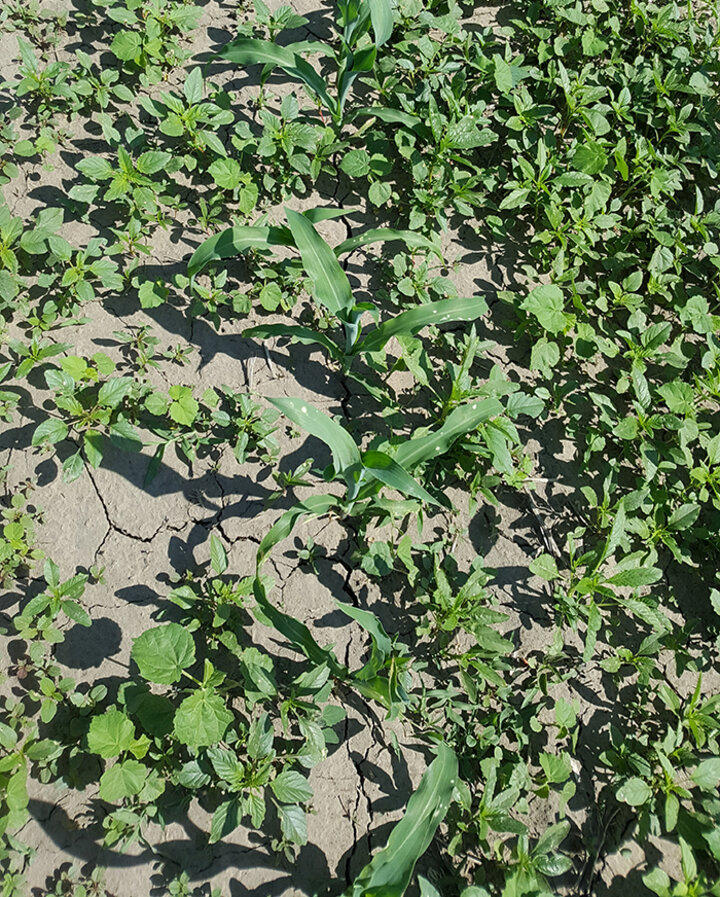Heavy rains and cooler soils in May in many areas of the state delayed planting or the application of preemergence herbicides. Early season weed control is important to avoid crop-weed competition and yield loss. Heavy rains also created a situation where preemergence herbicides washed off and the duration of their weed control efficacy was reduced. With plenty of soil moisture and warm temperatures the last two weeks promoting weed seed emergence and growth, some corn fields now have heavy infestations of weeds (Figures 1, 2).
Application of postemergence herbicide is an important weed management tool in corn, specifically this year in Nebraska. There are several points to be considered when applying postemergence herbicide, including corn growth stage, weed species present, and crop and weed heights.
Taller corn is generally more sensitive to potential herbicide injury, particularly when nozzles are applying herbicide directly into the whorl of the plant. Herbicide product labels provide a maximum corn growth stage after which broadcast applications should not be made (Table 1).

How to determine corn growth stage?
- Restriction of postemergence herbicide application in corn is based on growth stage listed on herbicide labels.
- They are primarily indicated as a particular corn leaf stage or plant height, and sometimes both are listed. The growth stage that is most restrictive should be followed when both are listed.
- When using a herbicide tank-mixture, follow the recommendations for the most restrictive label language of the products being used in the tank mix.
- Corn height is determined by measuring from the soil surface to the arch of the uppermost leaf that is more than 50% emerged (Figure 2).
- Corn leaf stage is determined by counting collars when leaves emerge from the whorl and a band is formed around the stem. Leaves that are just emerging from the whorl will not have a visible collar and are not counted. Leaf stages are designated using a "V" (vegetative) to represent each leaf during vegetative development. The first true leaf on corn is the short, rounded leaf near the soil surface which is counted as V1. Each successive, visible leaf collar is counted as V2, V3, and all the way to V18 which is prior to tasseling.
The Bottom Line
- It is important to pay attention to the corn growth stage noted on the label when applying herbicide. Herbicide applied beyond the growth stage may result in crop injury.
- Environmental conditions influence the absorption of postemergence herbicides and potential crop injury. Therefore, it is important to apply herbicides when crop and weeds are NOT under stress.
- Herbicide product labels should be followed regarding spray additives that are recommended for improved weed control.
- Do NOT apply postemergence herbicides with foliar fertilizers.
- It is important to clean the spray tank to avoid any potential crop injury due to spray tank contamination.
- Drop nozzles can be used in taller corn for better weed coverage and to avoid spraying directly into the whorl.
- If postemergence herbicides are applied later than mentioned on the label, corn ear development can be affected.
For more information on efficacy of the herbicides in Table 1, refer to 2017 Guide for Weed, Disease, and Insect Management in Nebraska.
| Postemergence Corn Herbicide | Corn Growth Stage or Plant height |
|---|---|
| 2,4-D | 8” broadcast; pre-tassel directed |
| Accent Q | 20” broadcast; 36” directed |
| Acuron | 12” |
| Aim | 8” |
| Armezon | V8 |
| Armezon PRO | V8 to 30” |
| Atrazine | 12” |
| Banvel | 1 pt 8”; 0.5 pint 36” |
| Basis Blend | 2 collar |
| Beacon | 20” broadcast; 36” directed |
| Buctril | Pre-tassel |
| Cadet | 48” or 70 days pre-harvest |
| Callisto | 30” or 8 leaf |
| Callisto GT | 30” or 8 leaf |
| Callisto Xtra | 12” |
| Capreno | V1 to V6 broadcast; V6 to V8 directed |
| Clarity | 8” |
| DiFlexx | Broadcast V6 or 36”; V7 to V10 or 36” directed; 15 days before tassel |
| DiFlexx DUO | V7 or 36” |
| Glyphosate | Read the label; broadcast to 24”; directed to 30” |
| Halex GT | 30” or V8 |
| Hornet | 20”; 85 days pre-harvest |
| Impact | 45 days pre-harvest |
| Laudis | V7 |
| Liberty (Only for Liberty Link Soybean) | 24”; V7; or 70 days pre-harvest |
| Lumax EZ/Lexar EZ | 12” |
| Realm Q | 20” or 6-leaf collar |
| Resicore | 10” |
| Resolve | 12” |
| Resolve Q | 20” or V7 |
| Resource | V10 |
| Revulin Q | V8 or 30” |
| Sencor | 60 days pre-harvest |
| Solstice | 48” or 70 days pre-harvest |
| Status | 36” |
| Steadfast Q | 20” or V6 |
| Stinger | 24” |
| Yukon | 36” |

